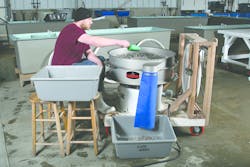Seed oyster production at the New Jersey Aquaculture Innovation Center at Rutgers University (AIC) is a large-scale operation by any measure. The 22,000-square-foot facility next to the Cape May Canal in Cape May, New Jersey, produces disease-resistant, fast-growing seed oysters for commercial grow-out, research and restoration of native oyster beds. It produces more than 10 million seed oysters annually to meet customer specifications, in particular those of East Coast commercial oyster producers.
Sorting by size for counting and redistribution in the nursery is a frequent and essential operation in the seed oyster production cycle. Originally, sorting with a 2-by-2-foot handheld screener was a daunting task, according to Matt Neuman, lead researcher and technician for hatchery production at the AIC. "It took all day for a three- or four-man crew to complete each round of sorting," he said, "and the added weight of seawater mixed with the product took a huge toll on everyone’s shoulders."
The search for a better way led to replacing manual screening with a more productive, mechanical 30-inch diameter circular vibratory screener manufactured by Kason Corporation of Millburn, New Jersey. With one operator now completing each day’s sorting in less than two hours, the equipment paid for itself in the first season.
Circular vibratory screeners separate bulk solid material from solids and slurries. The machines scalp (sift), de-dust and classify dry materials, and they dewater, clarify, and liquid-scalp in liquid applications.
The oysters’ aquaculture application is one of scalping — separating a small percentage of oversize solids from a large percentage of on-size solids.
The screeners find applications in industries including food, chemicals, minerals, metals, animal feeds, grains, pharmaceuticals, fertilizers, abrasives, wastewater, recycling, pollution control, pulp and paper, and ceramics.
Aquaculture innovation
As a research and education hub for New Jersey’s aquaculture community, the AIC studies and teaches methods of commercially raising seafood, benefiting a wide range of stakeholders — from aquaculture entrepreneurs and restoration specialists, to governmental resource managers and non-governmental organizations, to the fishing industry.
Among AIC’s projects is mass culturing of micro-algae using algal photo-bioreactors to increase yields of biochemical compounds with high potential value for food and pharmaceutical applications, as well as for shellfish such as oysters that are cultured for human consumption.
Juvenile oysters, under 1 millimeter in size, spend their first two weeks in large downweller tanks, where they are fed with cultured algae.
Seed oyster production
The Eastern Oyster (Crassostrea virginica) is among the shellfish species successfully cultured at the AIC using a micro-algae diet. The facility has been producing seed oysters from this strain since 2008. Seed oysters are small, about 2 millimeters to 25 millimeters long, provided primarily to oyster growers for the half-shell market. They are also used to restore natural oyster populations or natural ecosystems, and for research.
While natural oyster populations in the Delaware Bay spawn in late June or early July, at the AIC broodstock (adult oysters that produce baby oysters) are moved into temperature-controlled tanks in January, given plenty of microalgae food, and are ready to reproduce by late February. Fertilized eggs become microscopic oyster larvae, which are raised in filtered, sterilized seawater in 1,500-gallon culture tanks. After two to three weeks, the larvae metamorphose into juvenile oysters called spat. The growth cycle from spat to seed oysters takes several weeks to several months, depending on their intended size. Where oysters naturally clump together, AIC’s methodology yields individual oyster singles suitable for the half-shell market.
The first sorting operation in this growth cycle occurs when juvenile oysters are still under a millimeter in size, after spending about two weeks in filtered seawater in large downweller tanks, with regular feedings of cultured algae. Manual sorting in the downweller tank with a 1-by-2-foot handheld screen works efficiently for distributing the oysters at this tiny size to a series of 18-inch diameter upweller silos fed by raw seawater and whatever food it naturally contains.
As they grow, juvenile oysters are regularly sorted by size, counted and redistributed in the upwellers to optimize growth and survival. The number of seed oysters placed in individual silos is based on a volume determined by sub-samples. At full production late in the growth cycle, the AIC has 130 upwellers in use.
The AIC supplies some growers with seed oysters as small as 2 millimeters for cultivation in their own upweller systems. The remaining oysters at AIC grow at about a millimeter per week. Sorting to prevent overcrowding and to separate oysters by size becomes more frequent as they grow and with the increasing weight of the oysters more challenging to sort manually with handheld screens.
After leaving downweller tanks, juvenile oysters grow at about 1 millimeter per week in upweller tanks. Oysters are separated by size with the circular vibratory screener and redistributed by size to other upwellers to optimize growth.
Looking for a better way
More frequent sorting means dozens of operations are needed as seed oysters grow to 8 millimeters and larger, and daily sortings is required during the last weeks of the growing cycle. Faced with staff diversions for sorting manually and aching shoulders, the AIC’s Neuman took the lead in researching options.
He credits Kason independent representative Chris Dugan for streamlining his evaluation and purchase. While visiting the company’s headquarters and laboratory, Neuman and an AIC staff engineer observed the circular vibratory screener during test runs using a batch of seed oysters in different sizes. Neuman decided on a 30-inch diameter model for optimizing sorting yields and processing time.
Circular vibratory screener resolves issue
The circular vibratory screener now in use at the AIC is a single-deck model with four interchangeable screens sized at 8-, 6-, 4- and 2- millimeter mesh. Typical sorting operations involve several screen changes. Neuman also looked at the manufacturer’s multi-deck models for sorting multiple sizes simultaneously but determined "they were more than we needed for the scale of our operation."
The screener’s corrosion-resistant, stainless steel construction is essential for the AIC’s saltwater environment. Because saltwater is also corrosive to tools, Neuman specified a clamshell lid, quick change option to allow easy screen changeover without tools.
The deck of the circular vibratory screener is suspended on springs that allow screens to vibrate freely. An imbalanced-weight gyratory motor creates multiplane inertial vibration that controls the flow path of material on the screen surface and maximizes the rate at which undersized seed oysters pass through the screen while oversize ones migrate in controlled pathways to the periphery and through the discharge spout into a small tub. Undersized oysters exit from the lower discharge into a separate container.
Flow patterns can be adjusted by repositioning a bottom eccentric weight relative to the top eccentric weight. The AIC unit was delivered with factory settings of 45 degrees, which Neuman fine-tuned to 60 degrees, maximizing efficiency for his application. "Adjusting the angle on a bottom weight involves adjustment of only one bolt," he said.
Oysters are hand-fed slowly from a large funnel into the center of the screener at a rate of about a liter over 30 seconds. Neuman’s team is developing a new feed method using a corkscrew design to speed up this process while controlling the flow rate for a steady feed.
The AIC set up its vibratory screener on a mobile cart and plugs it in where needed. The screener allowed Neuman and his team to discard their old upweller handheld screens, making life easier on the seed oyster production line. "The new screener has freed seasonal staffing for other tasks, and it allows us to get bigger seed oysters out earlier, which our growers like," he said.
Henry Alamzad serves as president of Kason Corporation and head of Global Sales and Marketing. He previously served as Kason’s vice president of Sales and Marketing. Alamzad holds an MBA in marketing from New York Institute of Technology, a master of science degree in chemical engineering from City University of New York, and a bachelor’s of science in Chemical Engineering from University of Rhode Island.
For more information on the New Jersey Aquaculture Innovation Center at Rutgers University, visit aic.rutgers.edu. For more information on Kason Corporation’s Vibroscreen circular vibratory screener discussed in this article visit
kason.com.





